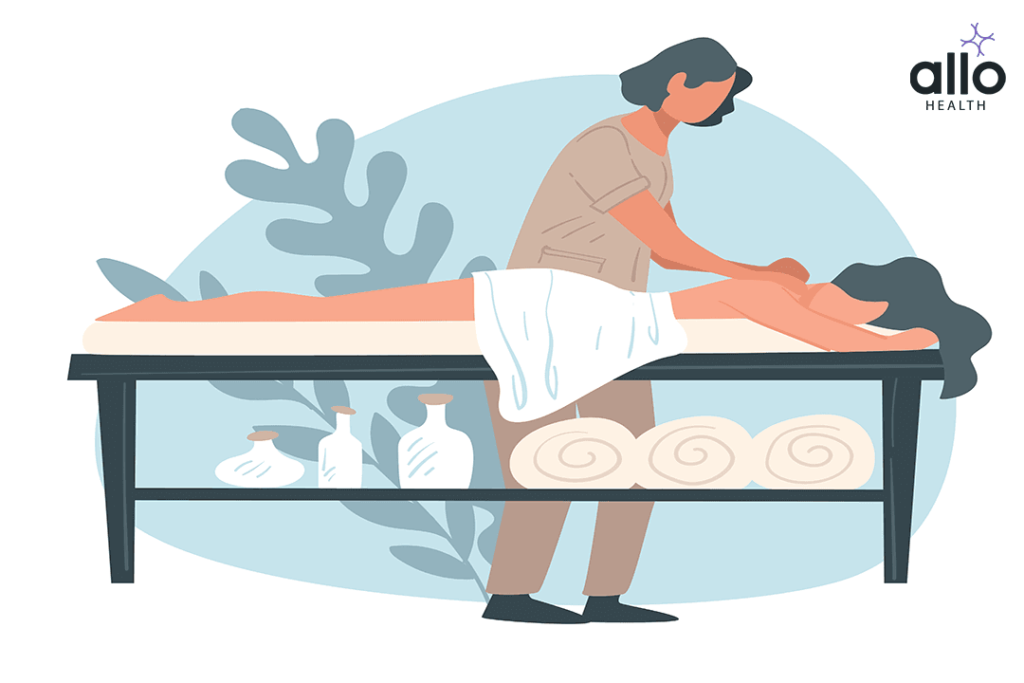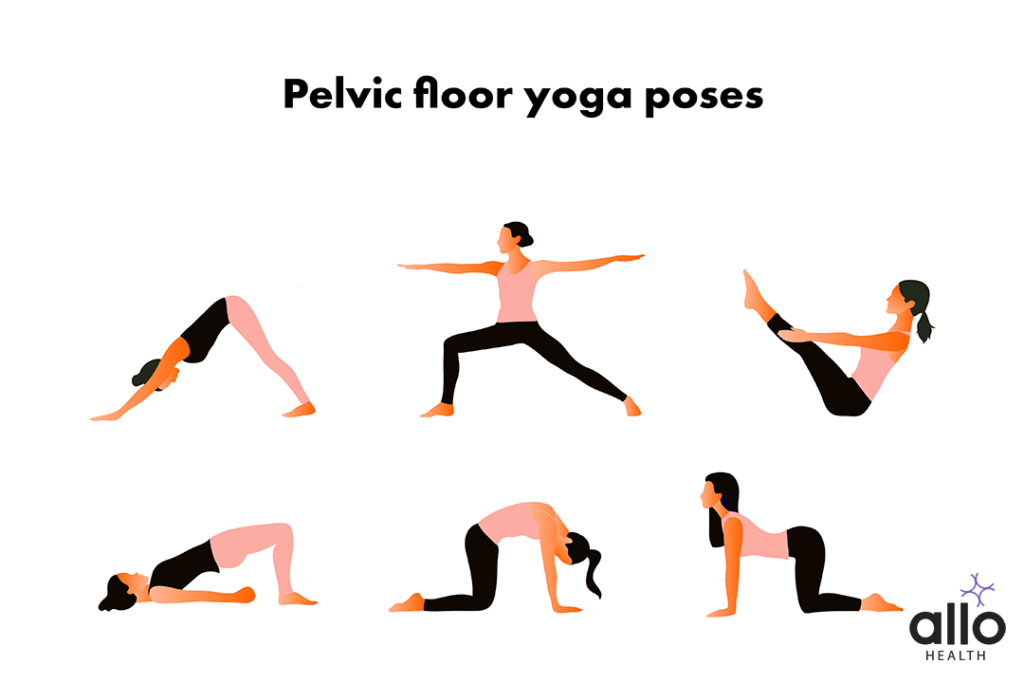Vaginismus Exercises

Allo Health is dedicated to personalized well-being, offering support and trusted information tailored to individual health goals. The platform emphasizes human-generated content, led by a distinguished medical team of experts, including physicians and sexual health specialists. Their commitment to credibility involves rigorous fact-checking, authoritative research, and continuous updates to ensure accurate, up-to-date information. Allo Health's unique approach goes beyond conventional platforms, providing expert-led insights and a continuous commitment to excellence, with user feedback playing a crucial role in shaping the platform's authoritative voice.

An early career psychiatrist with extensive experience in general adult psychiatry, relationship issues, psychosexual problems & special interest in sexual medicine, disorders with addictive behaviours and Obsessive Compulsive disorders. He is an astute physician with excellent academic record and research experience. He is also a member of World Health Organisation and World Psychiatric Association. His vision and goal for Allo is an inclusive, accessible digital health clinic for psychosexual difficulties.
Why This Was Upated?
Our experts continually monitor the health and wellness space, and we update our articles when new information became available.
Updated on 18 June, 2024
- Article was updated as part of our commitment to diversity, equity, and inclusion.

"The following blog article provides general information and insights on various topics. However, it is important to note that the information presented is not intended as professional advice in any specific field or area. The content of this blog is for general educational and informational purposes only.
Book consultation
The content should not be interpreted as endorsement, recommendation, or guarantee of any product, service, or information mentioned. Readers are solely responsible for the decisions and actions they take based on the information provided in this blog. It is essential to exercise individual judgment, critical thinking, and personal responsibility when applying or implementing any information or suggestions discussed in the blog."
Vaginismus is a physical condition or sexual condition in which the muscles in the vagina involuntarily spasm, making sexual intercourse and other forms of penetration painful or impossible. While the exact cause of vaginismus is not fully understood, it can be triggered by physical concerns, such as genital irritation or injury, or psychological factors, such as anxiety or trauma. However, the management of vaginismus is possible.
One way to manage the symptoms of vaginismus is through vaginal muscle exercises, also known as pelvic floor muscle exercises or Kegel exercises. These exercises can help to strengthen and relax the muscles in the vagina, reducing pain and improving sexual function.
Kegel Exercises
These exercises for vaginismus help to strengthen the pelvic floor muscles, which can help to relax the muscles of the vagina and improve control over them. To do Kegel exercises, squeeze the muscles you use to stop the flow of urine, hold for a few seconds, and then release.
Start by finding the right muscles to target. These are the muscles you use to stop the flow of urine midstream. Once you have located these muscles, you can perform Kegel exercises by squeezing and releasing them repeatedly for several seconds at a time. It is important to keep the muscles of the stomach, buttocks, and thighs relaxed while doing these exercises.
Kegel exercises can be done anytime and anywhere, and it is generally recommended to do them several times a day. As you get stronger, you can increase the number of repetitions and the duration of each contraction.
It is also important to consult with a healthcare provider before starting any new exercise routine, especially if you have any underlying health conditions. In some cases, vaginismus may require more extensive treatment process, such as therapy or medication.
Overall, Kegel exercises can be an effective way to manage vaginismus and improve sexual function. By consistently performing these exercises, you can strengthen the muscles in the vagina and reduce pain and discomfort during vaginal penetration.
Progressive Muscle Relaxation

Progressive muscle relaxation is a therapeutic technique that involves the systematic tensing and relaxing of different muscle groups in the body. It is often used to help reduce stress, anxiety, and muscle tension, and has been found to be particularly effective for women suffering from vaginismus.
Progressive muscle relaxation can be an effective treatment for vaginismus because it helps to reduce muscle tension and increase blood flow to the pelvic area. This can make it easier for women to relax and eventually overcome the muscle spasms that are causing their discomfort.
To practice progressive muscle relaxation, you can either lie down or sit in a comfortable position in a chair. Begin by tensing the muscles in your feet and holding for a few seconds, then slowly releasing the tension and feeling the muscles relax. Work your way up through each muscle group in your body, tensing and releasing as you go. It may be helpful to focus on your breath and take deep, slow breaths as you go through the process.
It is important to note that progressive muscle relaxation is not a quick fix for vaginismus. It may take several weeks or even months of regular practice before you begin to see improvements. However, with consistent practice, many women have found it to be a helpful tool in reducing muscle tension and overcoming vaginismus.
In addition to practicing progressive muscle relaxation, it may also be helpful to seek the support of a mental health professional or sex therapist. They can provide additional techniques and support to help you manage stress and address any underlying psychological concerns that may be contributing to your vaginismus.
In addition to pelvic floor muscle rehabilitation, a physical therapist may also use other techniques to treat vaginismus, such as:
Manual therapy
This may include massaging and stretching the muscles of the pelvic floor and surrounding areas to help reduce spasm and improve flexibility.
Education
A physical therapist can provide education about the anatomy and function of the pelvic floor muscles and how to properly perform Kegel exercises. They may also provide education about relaxation techniques and other strategies to help manage pain and discomfort during sexual activity.
Behavioral modification
A physical therapist may work with a person with vaginismus to identify and modify behaviors or thought patterns that may be contributing to the muscle spasm.
Visualization And Mindfulness Techniques
There are various visualization and mindfulness techniques that can help people with vaginismus manage their vaginismus symptoms and improve their quality of life.
One technique is visualization, which involves creating a mental image of a peaceful and relaxing scene in order to calm the mind and reduce anxiety. This can be particularly helpful for people with vaginismus, as anxiety and stress can often trigger muscle spasms and make the condition worse.
To try visualization, find a comfortable and quiet place to sit or lie down. Close your eyes and take a few deep breaths to relax your body. Then, imagine a scene that brings you peace and tranquility, such as a beach, a forest, or a mountain. Spend a few minutes focusing on the details of this scene, such as the sights, sounds, and smells. As you visualize this peaceful place, allow any tension or anxiety to melt away.
Another technique that can be helpful for people with vaginismus is mindfulness, which involves focusing your attention on the present moment and accepting your thoughts and feelings without judgment. This can help you better manage your emotions and reduce the intensity of physical symptoms like muscle spasms.
To practice mindfulness, find a quiet place to sit or lie down and focus your attention on your breath. As you inhale and exhale, try to stay present in the moment and let go of any thoughts or worries about the past or future. If your mind wanders, gently bring your attention back to your breath. You can also try incorporating mindfulness into your daily activities, such as by paying attention to the sensations of your body as you walk or eat.
Self-Touching
Self-touching, or self-exploration, can be an important part of treatment for vaginismus, a condition characterized by involuntary muscle spasm in the pelvic floor muscles, causing pelvic pain during sexual intercourse and difficulty with tampon use.
Self-touching can help individuals with symptoms of vaginismus become more comfortable with their bodies and increase their awareness of the sensations in their genital region. It can also help individuals with vaginismus learn how to relax their pelvic floor muscles, which can reduce pain and discomfort during sexual activity.
To begin self-touching as a treatment for vaginismus, it is important to create a safe and comfortable environment. This may involve finding a private space, setting aside dedicated time, and using lubrication to reduce discomfort.
It is also important to start slowly and listen to your body. Self-touching does not have to involve penetration, and it is okay to stop at any time if you feel uncomfortable or experience pain. You may find it helpful to explore your body using a mirror, or to use touch or visualization techniques to help you relax.
It is also important to communicate with your sexual childhood experiences partner about your self-touching practice and any concerns or boundaries you may have.
Self-touching can be a challenging and intimidating process for individuals with vaginismus, but it can also be a powerful tool for overcoming discomfort and increasing pleasure. Remember to be kind to yourself and go at a pace that feels comfortable for you. It may be helpful to work with a therapist or other medical professional to support you through this process.
Finger Insertion Exercises
Due to the fear associated with penetration, the goal is to help the patient become comfortable with insertion. Professionals suggest that, when ready, they should try to insert their fingers into their vaginal opening.
Graduated Dilators
Graduated dilators are cylinder-shaped devices that come in a set, with each successive dilator being slightly larger in diameter. They are made of smooth, body-safe materials such as plastic or silicone. The purpose of graduated dilators is to gently stretch and train the muscles of the vagina to relax, allowing for easier insertion of objects and eventually, pain-free sexual intercourse.
To use graduated dilators, it is typically recommended to start with the smallest dilator in the set and gradually work up to the larger ones as the muscles become more relaxed. This can be done under the guidance of a healthcare provider or at home with the help of a partner. It is important to go at a pace that is comfortable for the individual as plenty of lubrication in women may reduce friction and discomfort.
In addition to physical therapy with graduated dilators, it is often recommended that those with vaginismus also seek out other forms of treatment, such as counselling or pelvic muscle floor physical therapy. These approaches can help address the root causes of vaginismus, which can include emotional or psychological factors, as well as physical ones.
Overall, graduated dilators can be a useful tool in the treatment of vaginismus. By gradually stretching and training the muscles of the vagina, they can help reduce discomfort and improve sexual function for those affected by this condition.
Vaginal Trainers
Vaginal trainers are small, smooth, cylindrical objects that are inserted into the vagina to stretch and relax the muscles. They come in a set of graduated sizes, starting with the smallest size and gradually increasing in size as the muscles become more relaxed and accustomed to the sensation.
To use a vaginal trainer, you will need to start with the smallest size and gradually work your way up to the larger sizes as your muscles become more comfortable and relaxed. It is important to go at your own pace and stop if you experience any discomfort or pain.
Using vaginal trainers can be a bit intimidating at first, especially if you are not used to inserting objects into your vagina. However, with practice and patience, you can learn how to use these trainers effectively and comfortably.
Biofeedback
Biofeedback is a non-invasive, drug-free treatment option for vaginismus, a condition characterized by involuntary muscle spasms in the vagina. Vaginismus can make sexual intercourse or even inserting a tampon painful or impossible. It can also cause significant distress and impact a person’s overall quality of life.
Biofeedback involves using sensors to monitor and track physical body functions such as muscle tension, heart rate, and breathing. This information is then displayed on a monitor, allowing individuals to gain awareness and control over their body’s responses.
In the case of vaginismus treatment, biofeedback may involve sensors placed on the pelvic floor muscles to help individuals learn to relax these muscles and reduce involuntary spasms. Biofeedback can also be used to teach individuals how to regulate their heart rate and breathing, which can help reduce anxiety and improve overall relaxation.
One of the benefits of biofeedback for vaginismus treatment is that it is a completely non-invasive, drug-free option. It can be used in combination with other treatments, such as pelvic floor physical therapy, or as a standalone treatment.
Electrical stimulation
Electrical stimulation, also known as e-stim or electrotherapy, involves the use of a low-voltage electric current to stimulate the muscles and nerves in the vagina. This treatment can help to relax the muscles, reduce pain, and increase blood flow to the area.
There are several different types of electrical stimulation devices that can be used for the treatment of vaginismus. These include external devices that are applied to the outside of the vagina, as well as internal devices that are inserted into the vagina.
One common type of electrical stimulation device is the TENS (transcutaneous electrical nerve stimulation) unit. TENS units use a small, handheld device that is connected to electrodes placed on the skin. The device sends a low-level electrical current through the electrodes, stimulating the muscles and nerves in the vagina and helping to relax them.
Other types of electrical stimulation devices include vaginal dilators, which are inserted into the vagina and used to gradually stretch the muscles and tissues. Electrical stimulation can also be combined with other therapies, such as pelvic floor muscle exercises, to help improve muscle tone and control.

Massage Therapy
Massage therapy can help reduce the muscle spasms associated with vaginismus by promoting relaxation and increasing blood flow to the affected area. By releasing muscle tension and increasing circulation, massage can help to reduce pain and discomfort during sexual activity or pelvic exams.
In addition to the physical benefits, massage therapy can also have a positive effect on a woman’s mental and emotional well-being. The relaxing nature of massage can help reduce anxiety and stress, which are often contributing factors to vaginismus.
How Massage Therapy is Performed for Vaginismus Treatment?
Massage therapy for vaginismus treatment is typically performed by a trained and licensed massage therapist. The therapist will use a variety of techniques, including Swedish massage, deep tissue massage, and trigger point therapy, to relax the muscles of the pelvic floor and decrease muscle spasms.
The massage may be performed externally, on the lower abdomen and thighs, or internally, using a gloved and lubricated finger. The therapist will work with the woman to ensure that she is comfortable and relaxed throughout the massage.
Is Massage Therapy Right for You?
If you are suffering from vaginismus and are interested in trying massage therapy as a treatment option, it is important to consult with a healthcare professional. Your doctor can help you determine if massage therapy is appropriate for your specific case and can refer you to a qualified massage therapist.
In addition to massage therapy, there are other treatment options for vaginismus, including pelvic floor physical therapy, relaxation techniques, and counseling. Your healthcare team can help you determine the best course of treatment for your needs.
Sex Positions For Vaginismus
If you have vaginismus, it can be challenging to find comfortable and enjoyable sexual positions. However, with some adjustments and communication with your romantic partner, it is possible to find sexual positions that work for you and your body. Here are some tips and ideas for comfortable sexual positions that may be more comfortable for those with vaginismus:
Side by side
This position involves both partners lying on their sides facing each other. This position allows for a slower and more controlled penetration, which can be helpful if you are experiencing pain or discomfort.
Woman on top
This position gives the person with vaginismus more control over the depth and angle of penetration. It can also allow for the use of lubrication, which can make the experience more comfortable.
Spooning
In this position, both partners are lying on their sides with one partner behind the other. This position allows for a slower and more controlled penetration, and it can be helpful if you are experiencing pain or discomfort.
Doggy Style
In this position, the person with vaginismus is on their hands and knees while their partner enters from behind. This position can be helpful because it allows for a shallower penetration and can be adjusted to find a comfortable angle.
It is important to communicate with your partner and let them know what feels comfortable and what does not. You may also want to try using lubrication and taking breaks during penetration to help make the experience more comfortable.
Frequently Asked Questions
(1) What are vaginismus exercises and how do they work?Vaginismus exercises are techniques that help to relax the vaginal muscles and increase their flexibility and elasticity. These exercises can be performed at home, in the privacy of your own space, and typically involve using dilators or other objects to stretch the vaginal muscles. Some examples of vaginismus exercises include progressive dilation, the “stop-start” method, and the “squeeze” method.
(2) How long do I need to do vaginismus exercises for?
The length of time it takes to see results from vaginismus exercises can vary from person to person. It is important to be consistent and practice the exercises regularly to see progress. Some people may see improvement in just a few weeks, while others may need to continue the exercises for several months. It is also important to be patient and not to get discouraged if you do not see immediate results.
(3) Is it normal to experience discomfort or pain while doing vaginismus exercises?
It is normal to experience some discomfort or pain while doing vaginismus exercises, especially if you are just starting out. However, it is important to listen to your body and stop if the pain becomes too intense or if you experience any bleeding. If the discomfort or pain persists, it is a good idea to consult with a healthcare provider or a therapist who specializes in treating vaginismus.
(4) Can I do vaginismus exercises on my own, or do I need a partner or a healthcare provider?
You can certainly do vaginismus exercises on your own, using dilators or other objects to stretch the vaginal muscles. However, some people may find it helpful to work with a healthcare provider or a therapist who can provide guidance and support throughout the process. A healthcare provider or therapist can also help to identify any underlying conditions that may be contributing to the vaginismus and provide appropriate treatment.
(5) Are there any risks associated with vaginismus exercises?
Vaginismus exercises are generally considered safe when performed correctly. However, it is important to be gentle and not to force the dilator or other object into the vagina. If you experience excessive discomfort or pain, or if you experience bleeding, it is important to stop the exercise and consult with a healthcare provider.
(6) Does treatment for Vaginismus include surgery?
In particular, surgery may be considered if other treatments have not been successful, or if there is an underlying physical cause for the condition such as a structural abnormality or scar tissue.
One surgical option for vaginismus is vaginoplasty, which involves surgically tightening and reshaping the vaginal muscles. This procedure can be done using traditional surgery or laser surgery, and is usually performed under general anesthesia. Another surgical option is a Labiaplasty, which involves reshaping the labia (the inner and outer lips surrounding the vagina) to reduce discomfort or irritation during sex.
It’s important to note that surgery is not always necessary for the treatment of vaginismus, and other options such as therapy and pelvic floor exercises should be explored before considering surgery. It’s also important to talk to a healthcare provider about the potential risks and benefits of surgery before making a decision.
(7) Does Vaginismus mean vaginal pain?
While vaginismus is often associated with vaginal pain, it is important to note that not all people with vaginismus will experience painful intercourse or pain during sex. Some may only experience discomfort or difficulty with vaginal penetration, while others may not have any physical symptoms at all.
The severity of vaginismus can vary greatly from person to person. Some people may only experience symptoms in certain situations, such as with a new partner or after a significant period of time without sexual activity. Others may have more persistent symptoms that affect their ability to have penetrative sex on a regular basis.
(8) What is the difference between vaginismus and vulvodynia?
Vulvodynia and vaginismus are two common gynecological conditions that can cause discomfort or pain during sexual activity or while inserting a tampon. However, they are distinct conditions with different causes and treatment approaches.
Vulvodynia is a chronic pain disorder that affects the vulva, the external genitalia of women. It is characterized by burning, stinging, or raw pain in the vulvar area, often without any visible cause. Vulvodynia can have a significant impact on a woman’s quality of life and can cause discomfort during sexual activity, making it difficult to enjoy intimacy.
There are different types of vulvodynia, including provoked vulvodynia, which is triggered by certain activities such as sexual activity or tampon use, and unprovoked vulvodynia, which occurs spontaneously.
On the other hand, vaginismus is classified as either primary or secondary. Primary vaginismus occurs in women who have never been able to have penetrative sex, while secondary vaginismus occurs in women who have previously been able to have penetrative sex without difficulty. Treatment for vulvodynia and vaginismus may involve a combination of therapies, including medication, physical therapy, and counseling.
(9) What are some quick vaginismus exercises?
It can be hard to cope with the condition and many wonder how to get over vaginismus. Here’s a quick breakdown.
Vaginismus is a condition characterized by involuntary muscle contractions in the pelvic floor muscles, specifically the muscles surrounding the vagina. These contractions can make it difficult or even impossible for individuals to engage in vaginal penetration, including during sexual intercourse or the use of tampons. While there is no instant cure for vaginismus, certain exercises and techniques can help relax and strengthen the pelvic floor muscles over time. Here are some quick exercises that can be helpful:
- Deep Breathing: Deep breathing exercises can promote relaxation and help reduce muscle tension. Find a quiet and comfortable place to sit or lie down. Take slow, deep breaths in through your nose, allowing your abdomen to rise as you inhale. Exhale slowly through your mouth, allowing your abdomen to fall. Focus on fully relaxing your pelvic floor muscles as you breathe out.
- Pelvic Floor Muscle Relaxation: Pelvic floor exercises for vaginismus are very important. Learning to consciously relax the pelvic floor muscles is an important step in managing vaginismus. Start by finding a comfortable position, such as lying on your back with your knees bent. Take a few deep breaths and then focus on relaxing the muscles around your vagina. You can imagine a gentle opening or visualize the muscles releasing tension. Be patient and gentle with yourself as you practice this exercise.
- Pelvic Floor Muscle Contraction and Release: Strengthening the pelvic floor muscles can help improve control over muscle contractions. To perform this exercise, lie on your back with your knees bent. Imagine you are trying to stop the flow of urine or hold in gas. Squeeze the pelvic floor muscles tightly and hold for a count of three to five seconds. Then, release the muscles completely and relax for the same amount of time. Repeat this contraction and release cycle for about 10 repetitions, gradually working your way up to three sets of 10 repetitions each day.
- Kegel Exercises: Kegel exercises are a specific type of pelvic floor exercise that focus on strengthening the muscles involved in vaginismus. To perform a Kegel exercise, identify the muscles you use to stop the flow of urine midstream. Contract these muscles, hold for a few seconds, and then release. Aim for three sets of 10 repetitions per day. It’s important to note that Kegels alone may not be sufficient for vaginismus, but they can be a useful part of a comprehensive treatment plan.
- Dilator Therapy: Dilators are tools designed to help gradually stretch and desensitize the vaginal muscles. They come in a set of different sizes, starting with the smallest, and can be used to gently and gradually increase the size and tolerance of vaginal penetration. It’s best to consult with a healthcare professional or a pelvic floor physical therapist to receive guidance on the appropriate use of dilators.
Remember that these exercises may take time to produce noticeable results. It’s important to consult with a healthcare professional, such as a gynecologist or a pelvic floor physical therapist, who can provide a proper diagnosis and guide you through a comprehensive treatment plan tailored to your specific needs.
(10) How to get over vaginismus?
Getting over vaginismus typically requires a comprehensive approach and may vary depending on the individual. However, here is a simplified answer:
- Seek professional help: Consult with a healthcare professional who specializes in sexual health or pelvic floor disorders. They can provide a proper diagnosis, guidance, and a tailored treatment plan.
- Education and counseling: Learn about vaginismus and understand the physical and psychological factors that contribute to it. Counseling or therapy can help address any emotional or psychological issues related to vaginismus.
- Pelvic floor physical therapy: Work with a pelvic floor physical therapist who can guide you through exercises and techniques to relax and strengthen the pelvic floor muscles. They may also incorporate techniques like biofeedback or trigger point release.
- Gradual desensitization: Use vaginal dilators or other tools recommended by your healthcare professional to gradually and gently stretch and desensitize the vaginal muscles. Start with smaller sizes and gradually work your way up.
- Open communication with your partner: Involve your partner in the process and maintain open and honest communication about your condition. This can help reduce anxiety and create a supportive and understanding environment.
- Patience and self-compassion: Overcoming vaginismus can take time and progress may be gradual. Be patient with yourself and practice self-compassion throughout the journey.
Remember, vaginismus is a treatable condition, and with the right support and treatment, many individuals are able to overcome it and have fulfilling sexual experiences.
(11) How to treat vaginismus?
Vaginismus is a condition that can be treated, so if you’re wondering how to treat vaginismus at home or how you treat vaginismus. We got you.
The treatment of vaginismus typically involves a comprehensive approach that addresses both the physical and psychological aspects of the condition. Here are some common treatment approaches:
- Education and counseling: Understanding vaginismus and its causes can help alleviate anxiety and provide a foundation for treatment. Counseling or therapy can help address any emotional or psychological factors contributing to vaginismus, such as past trauma, relationship concerns, or anxiety.
- Pelvic floor physical therapy: Working with a pelvic floor physical therapist is often a key component of treatment. They can assess your pelvic floor muscles, guide you through exercises to relax and strengthen those muscles, and provide techniques such as biofeedback or trigger point release to address specific areas of tension.
- Gradual desensitization: Using vaginal dilators, a set of progressively sized cylindrical devices, can help desensitize and stretch the vaginal muscles. Starting with the smallest size and gradually progressing to larger sizes, this technique helps your body become more accustomed to vaginal penetration.
- Relaxation techniques: Learning and practicing relaxation techniques, such as deep breathing exercises, mindfulness, or guided imagery, can help reduce anxiety and tension in the body, including the pelvic floor muscles.
- Sensate focus exercises: These exercises involve gradually and sensually exploring different areas of the body, focusing on pleasurable sensations without the pressure of penetrative intercourse. This approach helps to build trust, intimacy, and relaxation between partners.
- Cognitive-behavioral therapy (CBT): CBT techniques can be used to challenge negative thoughts and beliefs about sexual intercourse, address performance anxiety, and develop healthier attitudes and expectations around sex.
- Medication: In some cases, healthcare professionals may prescribe medications such as muscle relaxants or low-dose antidepressants to help manage pain, anxiety, or other related symptoms.
It’s important to remember that treatment for vaginismus may vary depending on individual circumstances. It’s recommended to seek the guidance of a healthcare professional, such as a gynecologist, sexual health specialist, or pelvic floor physical therapist, who can provide an accurate diagnosis and develop a tailored treatment plan based on your specific needs.
It’s important to work with a healthcare professional, such as a therapist or get a gynecological exam, to determine the best treatment strategies for you. They can help you understand the underlying cause of your vaginismus and develop a treatment plan that is tailored to your needs of experiencing pain-free intercourse. Sexual disorder treatment is not a one size fit all deal, there are variety of treatment’s that can help with the recovery of vaginismus.












































